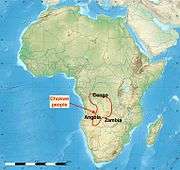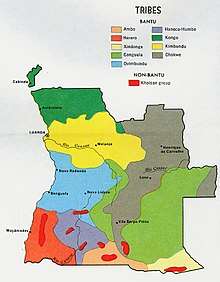Chokwe people
The Chokwe people, known by many other names (including Kioko, Bajokwe, Chibokwe, Kibokwe, Ciokwe, Cokwe or Badjok), are an ethnic group of Central and Southern Africa. They are found primarily in Angola, southwestern parts of the Democratic Republic of the Congo (Kinshasa to Lualaba), and northwestern parts of Zambia.[1]
.jpg) Chokwe artwork | |
| Total population | |
|---|---|
| 1.3 million[1] | |
| Regions with significant populations | |
| Angola, Congo DR, Zambia | |
| Languages | |
| Chokwe; many also speak French, Portuguese or English | |
| Religion | |
| Christian, Animist | |
| Related ethnic groups | |
| Ambundu, Ovimbundu, Luba, Lunda, Lwena, Songo |
Demographics and language
Estimated to be about 1.3 million,[1], their language is usually referred to as Chokwe (or Kichokwe, Tshokwe), a Bantu language in the Benue-Congo branch of Niger-Congo family of languages.[2]
Many also speak the official languages of their countries: English in Zambia, French in Democratic Republic of Congo, and Portuguese (as first or second language) in Angola.
History


The Chokwe were once one of the twelve clans of the great Lunda Empire of 17th- and 18th-century Angola.[3] They were initially employed by Lunda nobles, eventually became independent when they refused to continue paying tribute to the Lunda emperor. Their successful trading and abundant resources caused them to be one of the wealthiest groups in Angola. By 1900, the Chokwe had dismantled the Lunda kingdom (also called the Mwata Yanvo) altogether, using guns they had received in trade from the Ovimbundu. Chokwe language and influence then began to dominate northeastern Angola and spread among the Lunda peoples. As the wars and conflicts grew during the colonial era of the 19th and 20th centuries, both from Europeans from their west and the Swahili-Arabs from their east, they militarily responded and expanded further into northern Angola, Congo and into western Zambia.[4][5][6]
The Portuguese had virtually no contact with the Chokwe until the 1830s when the Chokwe traded wax, rubber and ivory. The Portuguese brought an end to the dominance of the Chokwe people in the region, but the Chokwe people fought back.
As a prince, Mwene Mbandu Kapova I of Mbunda played a significant role in the battle between the Chokwe and the Mbunda.
Slavery
In the 18th and 19th centuries, Chokwe people not only suffered from the consequences of slave capture and export, but themselves bought and kept slaves.[7][8] The Lunda nobles of Angola employed the Chokwe people as soldiers and hunters, first to counter the violence and threats to indigenous political power brought by the colonial demand and export markets for slaves, but once the Chokwe people had the guns, training and ethnic coordination, they overthrew the Lunda and employed slaves on their own for farming and domestic work in the second half of the 19th-century and the early decades of the 20th.[7] The slaves sourced from other ethnic groups of Africa became a prized possession sought by the Chokwe. In upper Zambezi river and Kasai regions particularly, they were once a victim of well armed Portuguese or Belgian raids from the West and Arab-Swahili raids from east (such as by Tippu Tip also known as Hamad bin Muhammad el Murjebi[9]); later, the Chokwe people joined the violence and victimized others by capturing and shipping out a substantial number of captured slaves for financial gains, as well as purchasing and keeping slave women in their own homes from the profits of their craft work.[8][10][11]
According to Achim von Oppen, the use of slaves among the Chokwe people was likely a cultural reality on a small scale, before the enormous growth in slave capture and trading activity for the Atlantic colonial market. The old practice had origins in inter-village disputes particularly after injury or murder, where the victim village sought revenge or a slave in compensation for the loss. In cases of giving up a person, it would preferably be a transfer of a child as a slave from the village that caused the loss.[8] As the demand and financial returns of slave trade to the colonial markets grew, many slaves were captured or otherwise passed through the Chokwe controlled territory. They would allow the movement of slave men to continue west towards the ports in cooperation with the Portuguese, while women were often kept.[8][12] This practice continued long after slavery was banned in Europe and the United States, but the demand for workers elsewhere such as in South America, the Caribbean, Swahili-Arabs, Omani and other colonial plantations market continued, feeding a smuggled slaves market.[13][10] European explorers who visited the Chokwe villages in early 20th-century reported that a majority of the women there were slaves in polygamous households and a cause of their population boom.[8] In certain regions, like other ethnic groups and Europeans, the Chokwe people used slaves to raid their neighbors for lucrative ivory stockpiles for exports as well as to counter the raids by militarized Arab-Swahili gangs seeking ivory stockpiles and tribute payments.[13][14][15]
Society and culture
The Chowke people live in woodland savanna, but are also found along rivers and marshland with strips of rainforest.[17] In the north, the Chokwe are known as skilled hunters. In south, their livelihood has traditionally centered around cultivation of staple crops such as cassava, yams, millet, beans, peanuts and corn (maize). Pastoral activity with cattle is also a part of the southern Chokwe people's life.[1][16]
They are regionally famous for their exceptional crafts work, particularly with baskets, pottery, mask carving, statues, stools and other handicrafts.[1][16] The art work include utilitarian objects, but often integrates Chokwe mythologies, oral history and spiritual beliefs. For example, the culture hero Chibinda Ilunga who married a Lunda woman and took over power is an often sculpted figure. The Cikungu art personifies the collective power of Chokwe's ancestors, while Mwana po figurines depict the guardians of fertility and procreation. The Ngombo figurines have been traditionally a part of divining spirits who are shaken to tell causes of illness, misfortune, not having babies and other problems faced by a family or a village.[18][19]
Both chiefs and village groups are found in the Chokwe culture. Villages consist of company compounds with square huts or circular grass-houses with a central space that serves as the meeting place for the villagers.[1]
The Chokwe are traditionally a matrilineal society, but where the woman moves to live with her husband's family after wedding. Polygyny has been a historic practice usually limited to the chief or a wealthy family.[1]
The traditional religious beliefs of the Chokwe center around ancestor spirits worship.[3] In groups where chiefs exist, they are considered the representative of god Kalunga or Nzambi, therefore revered and called Mwanangana or "overseer of the land". The Chokwe people believe that works of arts such as handicrafts and carved objects are spiritual, connect them to their ancestors and god Kalunga or Nzambi. With the colonial era, Chowke converted to Christianity en masse yet the original beliefs were retained to produce a syncretism of beliefs and practices.[3] They have, for example, continued their spirit-rituals from pre-Christian era, as well maintained their elaborate rites-of-passage ceremonies particularly to mark the entry into adulthood by men and women.[1][3]
In popular culture
A Chokwe statue, Chokwe body carvings, blood diamonds, and the Chokwe people figure into the plotline of Donna Leon's 14th Commissario Guido Brunetti mystery novel, Blood From a Stone (2005).[20][21]
See also
References
- Chowke people, Encyclopædia Britannica
- Cokwe, Ethnologue (2007)
- Molefi Kete Asante; Ama Mazama (2009). Encyclopedia of African Religion. SAGE Publications. pp. 165–166. ISBN 978-1-4129-3636-1.
- Jeremy Black (2013). War in the Modern World Since 1815. Routledge. pp. 175–179. ISBN 978-1-136-40233-3.
- Manuel Jordán (1998). Chokwe. The Rosen Publishing Group. ISBN 978-0-8239-1990-1.
- Joseph Miller (1970). "Chokwe Trade and Conquest in the Nineteenth Century". In Richard Gray and David Birmingham (ed.). Pre-Colonial African Trade: essays on trade in Central and Eastern Africa before 1900. Oxford University Press.
- Phyllis Martin; Patrick O'Meara (1995). Africa. Indiana University Press. pp. 126–127. ISBN 0-253-20984-6.
- Achim von Oppen (1993). Terms of Trade and Terms of Trust: The History and Contexts of Pre-colonial Market Production Around the Upper Zambezi and Kasai. LIT Verlag Münster. pp. 285–291 with footnotes. ISBN 978-3-89473-246-2.
- Kevin Shillington (2012). History of Africa. Palgrave Macmillan. pp. 259–263. ISBN 978-1-137-00333-1.
- Roland Oliver; Anthony Atmore (2005). Africa since 1800. Cambridge University Press. pp. 81–89. ISBN 978-1-139-44398-2.
- Robert Aldrich; Kirsten McKenzie (2013). The Routledge History of Western Empires. Routledge. pp. 461–464. ISBN 978-1-317-99987-4.
- Manuel Jordán (1998). Chokwe. The Rosen Publishing Group. pp. 29–30. ISBN 978-0-8239-1990-1.
- David Gordon (2013). Robert Ross; et al. (eds.). The Objects of Life in Central Africa: The History of Consumption and Social Change, 1840-1980. BRILL Academic. pp. 30–35. ISBN 978-90-04-25624-8.
- John E. Flint (1977). The Cambridge History of Africa. Cambridge University Press. pp. 243–247. ISBN 978-0-521-20701-0.
- Timothy J. Stapleton (2013). A Military History of Africa. ABC-CLIO. pp. 186–198. ISBN 978-0-313-39570-3.
- Manuel Jordán (1998). Chokwe. The Rosen Publishing Group. pp. 11–12. ISBN 978-0-8239-1990-1.
- Manuel Jordán (1998). Chokwe. The Rosen Publishing Group. pp. 12–14. ISBN 978-0-8239-1990-1.
- Hope B. Werness (2003). Continuum Encyclopedia of Native Art: Worldview, Symbolism, and Culture in Africa, Oceania, and North America. Bloomsbury Academic. pp. 59–60. ISBN 978-0-8264-1465-6.
- Hans-Joachim Koloss (1990). Art of Central Africa: Masterpieces from the Berlin Museum Für Völkerkunde. Metropolitan Museum of Art. pp. 50–53. ISBN 978-0-87099-590-3.
- Leon, Donna (2005). Blood From a Stone. Atlantic Monthly. ISBN 0-87113-887-5. (e.g., in Chapters 26 and 27)
- "Review: Blood From a Stone by Donna Leon". Kirkus. 2005.
Further reading
- Areia, M. L. Rodrigues de. Chokwe and their Bantu neighbours. Zürich: Jean David & Gerhard Merzeder, 2003.
- Areia, M. L. Rodrigues de, and Roland Kaehr. Les masques: collections d'Angola 2. Collections du Musée d'ethnographie de Neuchâtel 7. Neuchâtel: Musée d'ethnographie, 2009.
- Bastin, Marie Louise. Art décoratif tshokwe. 2 vols. Lisboa: Companhia de Diamantes de Angola, Serviços Culturais, 1961.
- Bastin, Marie Louise. La sculpture tshokwe. Meudon: A. et F. Chaffin, 1982.
- Cerqueira, Ivo Benjamin. Vida social indígena na colónia de Angola: usos e costumes. Lisboa: Divisão de Publicações e Biblioteca, Agência Geral das Colónias, 1947.
- Delachaux, Théodore, and Charles-E. Thiébaud. Pays et peuples d'Angola: études, souvenirs. Neuchâtel: Éditions Victor Attinger, 1934.
- Jordán, Manuel, ed. Chokwe!: art and initiation among Chowke and related peoples. Munich: Prestel-Verlag, 1998.
- Wastiau, Boris. Chokwe. Milan: 5 Continents, 2006.
External links
| Wikimedia Commons has media related to Chokwe people. |
_(3041251407).jpg)
